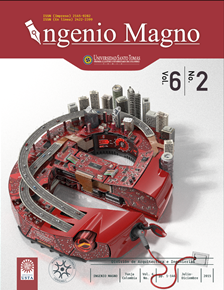Propiedades mecánicas de un compuesto polimérico hecho de polietileno de baja densidad reciclado y reforzado con fibras de madera natural
Contenido principal del artículo
Resumen
Descargas
Detalles del artículo
DECLARACIÓN DE ORIGINALIDAD DE ARTÍCULO PRESENTADO
Por medio del presente documento, certifico(amos) que el artículo que se presenta para posible publicación en la revista institucional INGENIO MAGNO del Centro de Investigaciones de Ingeniería Alberto Magno CIIAM de la Universidad Santo Tomás, seccional Tunja, es de mi (nuestra) entera autoría, siendo su contenido producto de mi (nuestra) directa contribución intelectual y aporte al conocimiento.
Todos los datos y referencias a publicaciones hechas están debidamente identificados con su respectiva nota bibliográfica y en las citas que se destacan como tal. De requerir alguna clase de ajuste o corrección, comunicaré(emos) de tal procedimiento con antelación a los responsables de la revista.
Por lo anteriormente expresado, declaro(amos) que el material presentado en su totalidad se encuentra conforme a la legislación aplicable en materia de propiedad intelectual e industrial de ser el caso, y por lo tanto, me(nos) hago (hacemos) absolutamente responsable(s) de cualquier reclamación relacionada a esta.
En caso que el artículo presentado sea publicado, manifiesto(amos) que cedo(emos) plenamente a la Universidad Santo Tomás, seccional Tunja, los derechos de reproducción del mismo.
Citas
Ashori, A. y Nourbakhsh, A. (2009). Characteristics of wood–fiber plastic composites made of recycled materials. Waste Management, 29, 1291-1295.
ASTM International (2010). ASTM D790-10: Standard Test Methods for Flexural Properties of Unreinforced and Reinforced Plastics and Electrical Insulating Materials. Recuperado de http://wenku.baidu.com/ view/97d9964de518964bcf847c39.html Ghahri S. (2014) Influence of Impact Modifier And Coupling Agent On Impact Strength Of Wood Flour / Recycled Plastic Composites. Proligno Vol. 10 No. 1, 3-9.
Jayaraman, K. y Bhattacharya, D. (2004). Mechanical performance of wood fibre–waste plastic composite materials. Resources, Conservation and Recycling, 41, 307-319.
Jayaraman, K., Halliwell, R. (2009). Harakeke (phormium tenax) fibre–waste plastics blend composites processed by screwless extrusion. Composites, 40(part B), 645649.
Kazemi Najafi Saeed (2013). Use of recycled plastics in wood plastic composites – A review. Waste Management 33, 1898-1905.
Kotiba, H., Kaseem, M. y Deri, F. (2013). Review article: recycling of waste from polymer materials: An overview of the recent works. Polymer Degradation and Stability, 98, 2801-2812.
Saeed, K. (2013). Use of recycled plastics in wood plastic composites – A review. Waste Management, 33, 1898-1905.
Zárate Ramírez, J. y Gutiérrez Junco, O. (2012). Caracterización de maderas usadas en Boyacá de 85 acuerdo con el Reglamento Construcción Sismo Resistente. Revista Facultad de Ingeniería UPTC, 21(32), 73-91.

